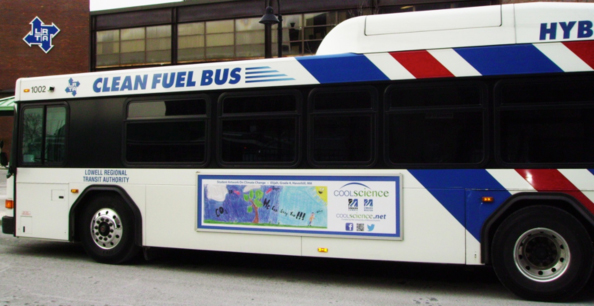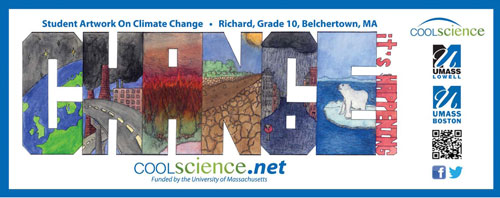Cool Science: Using Mass Transit to Bridge Formal and Informal Learning about Climate Change
Cool Science is an innovative approach to bridging the worlds of informal and formal science education. Cool Science hosts a climate change art competition for K-12 students throughout the state of Massachusetts. Using the visual arts as a medium, Cool Science engages teachers, parents, and students in climate change science. Then, by displaying the winning student artwork throughout the Lowell Rapid Transit Authority (LRTA), we foster a unique approach to facilitating informal science learning among the riding public. Using children’s artwork to communicate complex scientific issues is a powerful learning experience for the artist, teacher, and the audience. In fall 2012, Cool Science received nearly 600 entries from students representing 36 teachers from 32 school districts. A distinguished and interdisciplinary panel selected six winning entries, six runners-up, and twelve honorable mentions in December. The six winning entries went on public display throughout the LRTA, including posters in the Gallagher Transit Terminal, placards inside every bus, and banners on the exteriors of selected buses in January, with one work of art being highlighted each month until June 2013. With the LRTA averaging more than 5,000 riders a day, our potential audience rivals the daily attendance at the largest science museums. For the winning students, it is an unforgettable experience to see the nine-foot version of their artwork traveling around the streets on the side of a bus!

Cool Science emerged from the NSF-funded Carbon Smarts Conference in October 2011 (DRL-1049317), which brought leading experts in climate science, marketing, science communication, formal, and informal science education together to discuss the challenges of using Out-of-Home Media (OOHM) to engage public audiences with climate change science. Cool Science investigates the question, How might Out-of-Home Media engage the riding public in the science of climate change while serving as an incentive to foster science learning among teachers and students? OOHM involves advertising in public spaces with billboards, placards, and posters. With the advent of smart-phone technology, OOHM is currently enjoying a boom in popularity and creativity as the field finds new ways to compete for the attention of people while outside their home. OOHM represents a form of communication that has a long history of success and popularity among for-profit and non-profit organizations alike. It is attractive to a broad range of parties due to its effectiveness, relatively quick production time, and low implementation costs when compared to radio, television, or print. As a medium for informal learning, OOHM represents a relatively unexplored territory.
To evaluate the impact of Cool Science upon the riding public’s awareness, attitudes, and understanding of climate change, the research team implemented a pre-post quantitative design. In the fall prior to the public display of any student artwork, LRTA riders were surveyed (n=360) using our Carbon Awareness and Attitudes Survey instrument. After all project media stops running at the end of June 2013, a post survey of riders will take place. For the formal teaching and learning aspects of Cool Science, assessment utilized a qualitative approach. Beginning in May 2013, winning students and their teachers participated in interviews focused on how the Cool Science art competition was experienced at the classroom level. When analysis is complete, the results of these interviews will reveal the strengths and weaknesses of the project and indicate how to improve the project’s effectiveness for future rounds.
In addition to these primary streams of data, there are some important secondary sources. The project website (www.coolscience.net) monitors hits per month, and the surfing choices of visitors. Cool Science’s presence in social networks (Facebook and Twitter) provides longitudinal data indicating the most popular phases of the project. Response and coverage of Cool Science by print media produced a collection of stories about the project with local papers publishing profiles of student winners from their respective communities. Finally, in April 2013, the University of Massachusetts Lowell’s Graduate School of Education hosted the Cool Science Awards Ceremony, which formally recognized the six winners, six runners-up, and twelve honorable mentions. Attended by more than 100 people including students, their teachers, and families from all over the state, the ceremony was a successful and rewarding experience for everyone in attendance.
While evaluation efforts continue, some preliminary conclusions are apparent. Evidence indicates that Cool Science was a welcome opportunity for teachers to weave climate change into their demanding curriculums. Influencing curricular reforms in K-12 education is notoriously difficult and time consuming. Because Cool Science was a public competition for any K-12 student in Massachusetts, formal arrangements with schools and/or districts were not required. Eligibility for the art competition required only state residency for the students. Students could work on their submission as part of a classroom project or at home under the supervision of a parent or caregiver.
With regards to the informal learning audience, preliminary results indicate that the student artwork was very positively received. Comments from riders, bus drivers, and administrators all support the idea that the Cool Science artwork represents a welcome change of pace to the traditional advertisements that usually occupy these spaces. Project leaders look forward to learning whether the post-survey of riders identifies any specific changes in attitudes, awareness, and knowledge of climate change. Look for results of all of the project's evaluation and research findings in upcoming CAISE communications.
To extend the life of Cool Science beyond the life of the Creative Economy Grant (which ends in June 2013), the research team is actively developing strategies to create a sustainable financial model with the goal of making Cool Science an annual event in Massachusetts. Currently, the research team is seeking foundation, alumni, corporate, and public sponsors. In addition to letters of inquiry, networking, and applications, Cool Science will seek support through crowd-sourcing opportunities. The project offers potential partners several key attractive benefits. By supporting Cool Science, a partner can:
- Receive effective promotion of their brand for a fraction of the cost.
- Enrich their brand name by being associated with quality science and art education.
- Strengthen their regional reputation as a “green” agent of change.
In addition, Cool Science will be selling winning artwork on calendars, coffee mugs, and t-shirts with all proceeds going to fund future rounds of the project. If projects such as Cool Science are to become sustainable, innovative funding models must be investigated and established.
Funded by a Creative Economy Grant from the University of Massachusetts ($32,500) in June 2012, the Cool Science Team includes David Lustick and Jill Lohmeier from the University of Massachusetts Lowell and Robert Chen from the University of Massachusetts Boston. 